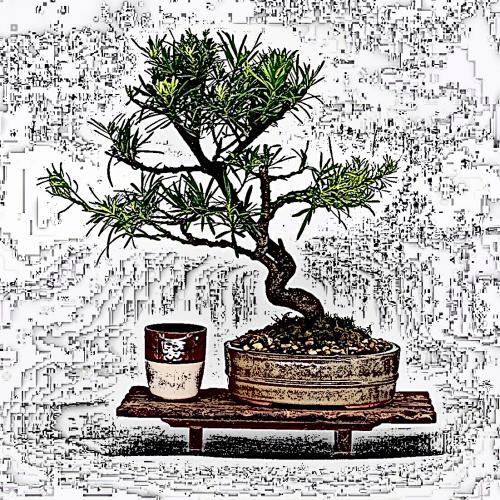Bonsai class 6

[This is a continuing series of spontaneous and unrehearsed "classes" on the subject of bonsai. Many new readers were coming on board asking about how to get started. I believe you should just start making bonsai. So, I will try to lead you through creating your first. Besides this gentle counsel, be sure to read the FAQ (which appears periodically) and search out some good books or people to introduce you to the subject. I will post sporadically with a subject containing the word "Class". I am going slow, so be prepared to be frustrated. If you have questions or comments about building your own first bonsai, post them "Re:" this thread. Write me (rkn@guest.apple.com) for back issues. -Hud]
===
I told you I had purchased 3 trees a couple of weeks ago, so I could share the adventure, and maybe help inspire you. Let me tell you about them. All were recently purchased at a landscape nursery, on sale for US $2.95.
Subject 1 was a Japanese black pine (Pinus Thunbergii) in a 1-gallon pot, with new sprouts making it about 12 inches tall.
Subject 2 was a mugho pine (Pinus mugo) in a 1-gallon pot, about 10 inches tall.
Subject 3 was a juniper (Juniperus chinensis procumbens nana), in a 1- gallon pot, about 7 inches tall.
And, let me describe a bonus Subject 4: a volunteer ($0.00!) deciduous tree I saw growing in a flower box two years ago. It could be a willow but I think it is a peach (Prunus persica); that would be like me-- eating a peach out on the deck and lazily tossing the stone into the flower box instead of properly disposing of it! I let it grow the first year just to see what it was, and it grew straight up, reaching a height of about 4 feet, with a base trunk diameter of 3/8 inch. That winter, seeing that it had an attractive, gentle S-curve near the base, I transplanted it to a 1-foot diameter clay azalea pot, and cut the trunk clean off at 6 inches. Last spring, it developed 8 branches in good places; I let them grow to develop girth. By winter, the trunk diameter was 5/8 inch.
On with the results.
1) Japanese black pine
This classic bonsai material seduced me. It was an impulse buy (Hey, they were on sale!) and I didn't have much to choose from. It had a nice 1/2-inch trunk, but was lacking in attractive branches. Three inches up, four wheel-spoke branches emerged. A half- inch further up, three more branches emerged. Each of the branches had new buds at about 2 inches, and the ends of every branch had new, long growth.
The first thing I did was remove needles from the trunk and the lower part of the main branches, just so I could see how things looked. I then pinched out most of the new end growth on the branches to get a more realistic idea of the finished height.
It really needed a first branch, so I removed all but the one best of the first set of wheel-spoke branches. There went about half the foliage! I still didn't know if the first branch went left or right.
The second branch, one of the three a half-inch up, would determine that. One went the same direction as the first branch, so I removed it. Both of the other two branches grew about ninety degrees to the first branch, so there wasn't an easy choice. I kept the thickest one. I will wire and bend it around so it is more opposite the first branch. This left me with a first branch that is on the right, and a second branch that will come left from the rear half of the tree. Although the branches are at ninety degrees, if I also swing the first branch a little toward the front, then the bases of both branches can be seen.
I still don't have a back branch, but there is a sprout at the rear that has possibilities. But, it is about the same height as the first two branches, so it will probably have to go. I'll probably have to get a back branch from the sprouts two inches farther up the trunk.
I cut each branch back to about 2 inches, where their new sprouts were, leaving the tree about 6 inches tall. They will form nice branches eventually, but right now it doesn't look much like a bonsai.
To help that, I did some needle cutting. The needles on this tree were 5 to 6 inches long. They aren't now! I cut them back to 1 to 1-1/2 inches. This leaves about 15% of the needles the tree originally had; I hope it is strong! It's still not a bonsai, but in a couple years...
2) Mugho pine
This tree had more potential. The trunk was almost an inch in diameter, and there was a clear winner of a first branch, about a half-inch in diameter, that grew horizontally for an inch and then up. Besides a lot of smaller branches on the trunk, there was a good-sized branch that could be a back branch, which would demand that the first branch goes left. I removed all of the smaller branches from the lower part of the trunk, leaving the first branch, the back branch, and the trunk.
Unfortunately, there is no clear second branch going to the right. I turned this tree around and around, trying to figure out exactly where the front was. (A lazy-susan, or turntable, can be useful at this stage.) Up the trunk from the first two main branches, there is a cluster of three branches. The inner one is probably the apex. One of the other two will be the second branch, and will be wired out to the right. I can't decide which one right now. I have to think about it more.
I pruned back all of the branches to just above their new buds, leaving it about 8 inches tall. All of the branches look a little gangly, about 6 inches right now, but maybe some new branches will grow lower down next spring, and then I can shorten them. Yeah, next spring, that's the ticket! Next spring, it will look great.
But, in general, the tree already has a nice form, and makes a pretty good bonsai, for a half-hour of pruning and a couple hours of pondering.
3) Juniper
This tree had a nice half-inch diameter trunk that grew up two inches, two inches at forty-five degrees, and then up and curving for about 18 inches of horizontal growth. Typical of junipers, it had a lot of branches, and the trick was just selecting the right ones to make a bonsai.
I decided on a first branch that came out a little below the first curve in the trunk. I plucked out all the little branches on the lower part of the trunk, to better see the structure. There was a good candidate for a second branch on the second curve of the trunk. Above it was a branch that came out of the trunk almost on the opposite side. I decided that would be wired to become the back branch, and that the first branch would therefore be on the right. I removed the smaller branches from the lower third of each of the main limbs.
Since the main trunk curved to grow horizontally, it had to be bent upward to supply an apex. I shortened it to about 8 inches and selected one of its side branches to become the new apex. I decided to wire the trunk to bring it up vertically. Ah! Nice. Instead of sweeping off horizontally to the right, it now curved forward and upward to the left. Suddenly it looked like a tree.
[We haven't really talked about wiring techniques, so you don't have to worry about that on your tree; just shape the tree by pruning and remember that some of the remaining branches can be moved around a little to complete the form.]
Then, disaster struck. In rolling it around, reducing its size, and wiring, somehow the first branch was broken severely at the trunk. Damn! Well, see, we all make mistakes!
While I could try to save the branch by wiring it in place and letting it heal, I decided to revisit my decisions about branches. I mentally removed it and saw that what had been my second branch would make a pretty good first branch, even though it was a little far off the ground, just under half the way up to the apex. No problem.
Now, I can't lower that branch so it comes out from the trunk at 1/3 the height of the tree, but I can make the tree taller! The tree will grow in the future to make the proportions better, but I couldn't wait. The apex branch was sweeping to the left; I brought the last couple of inches to vertical and instantly the proportions were better.
It looked great. Off went the former first branch!
The former second branch, going to the left, was promoted to be the first. The branch I had envisioned as the back branch became the second branch, going to the right. Another branch, a little further up, became the back branch.
This was close to being a great "instant bonsai", so I continued. I shortened all of the branches. On the lower branches, I removed all twigs growing straight up (looking too youthful) or straight down (looking plain ugly). This leaves the remaining twigs all growing out horizontally, giving the outer portion of each branch the appearance of a little green cloud of needles.
The second branch bothered me. I had removed all twigs for half its length, in preparation to bending it around to function as the back branch. But now, as the second branch, the foliage seemed too far from the tree. I wired this branch and bent its lower third into a sinuous curve, pulling the foliage in closer to the trunk. It improved the overall balance, and made the branch more interesting in the bargain!
The tree looks a tad sparse right now, but a summer of pinching to encourage new growth will solve that. If I add a little jin (that's jin, not gin--removing bark to make a dead limb for the effect of age), it'll be perfect. I don't really have a branch to spare right now, so that is something to look forward to in the future.
4) Peach
By this spring, the tree had a 5/8-inch diameter trunk, about 6-inches long, with a subtle S-curve, and 8 two-foot long branches, nicely spaced up the trunk. Important branches had grown on the outside of the curves in the trunk; it seemed like this tree just wanted to be a bonsai! About two months ago, just before budding, I cut back the upper four branches to about 4 inches. I left the lower four branches long, still, to encourage girth. At that point, the tree looked really ugly!
As it began to develop leaves, I experimented with pinching them back, just to see how it went. It went well; it always quickly put out new shoots. The wound from the very first topping was beginning to heal nicely. Among its new spring growth was a new branch on the trunk, in almost the exact place one was needed; I let that grow long, as well, to develop girth.
Now, since the tree seems very healthy, the time had come to turn this ugly duckling into a beautiful bonsai. I just cut all of its branches back to 1/2 to 1 inch (pruning, of course, so that buds on the end of the branches are located on the bottom or outside). In a week or two, I'll know if the operation was a success. I expect the nine short branches to soon each be sporting several new branches. Then, it will look really nice. I'll have to stay on top of this one; it will require constant pinching back so that it develops dense foliage and short internodes. I will still have to let the lower branches grow, for their diameter is still less than the upper branches, but I know that will be fixed.
I think it's got what it takes!
===
So, out of 3 nursery trees bought for $9 total, and a found freebie (I'll have to throw some more peach pits in the flower box!), I have one nice juniper bonsai, one mugho that is OK but will be a good bonsai next year, a black pine that won't be anything for a couple years, and a peach that will look superb in about 3 years. Not bad! (Patience? Nah, patience is for people who don't like what they are doing.)
Next time, I'll report on what I did to the lower half of the trees. Don't forget the roots!
===
I just read a cute trick for beginners, to practice pruning: snip a branch off a big tree and prune and shape it as if it were a bonsai. If you really doubt your ability to find the bonsai hiding in your subject, doing a few of these might help you gain confidence. At least your mistakes won't matter.
===
A while ago, I mentioned that a good overall shape for a bonsai was triangular. That is especially true of conifers, for that is their natural form. Other shapes, usually geometric, are possible. For instance, I'll probably prune the peach to attain an oval outline. Let the shape of a similar mature tree be your guide to the shape you give your bonsai.
===
So, how is your tree? Any problems? Through E-mail, some people have told me they have acquired trees to turn into their first bonsai. Let me know how it's going -- privately, or in this forum, whichever you prefer. I appreciate the feedback.


















